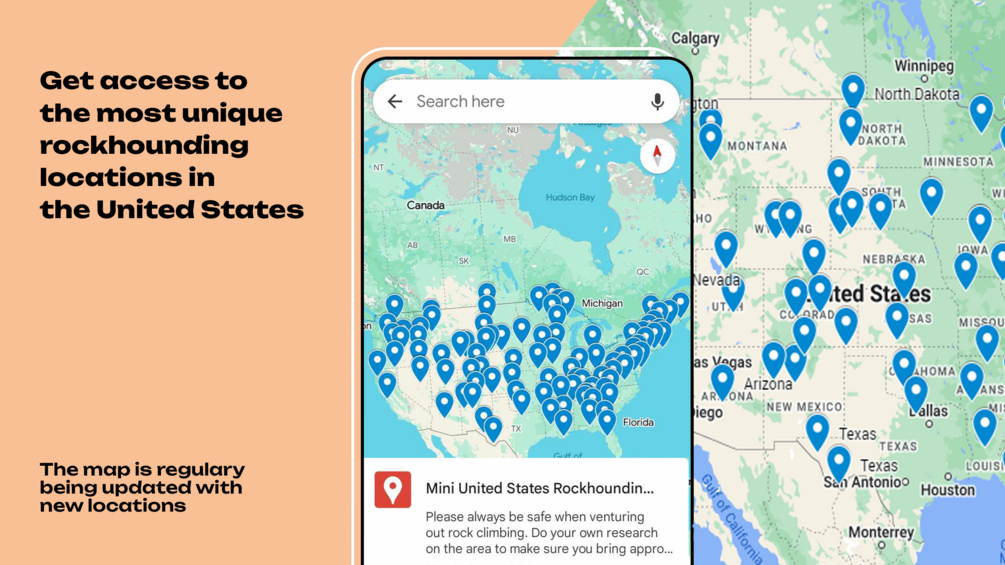Ready to explore the hidden treasures of the North Star State?
Minnesota’s diverse geology makes it a rockhound’s paradise, with a variety of minerals and fossils just waiting to be discovered. Whether you’re a seasoned collector or a curious beginner, the state’s scenic landscapes offer more than just a beautiful view—they’re a gateway to some truly unique geological finds.
From the famed Lake Superior agates to the ancient fossils of the Bluff Country, Minnesota’s rich terrain is a treasure trove for enthusiasts. You’ll find an array of sites across the state that cater to your rockhounding adventures.
So grab your gear and let’s uncover the best spots to add some remarkable pieces to your collection.
Minnesota’s diverse geology offers a rockhound’s paradise with Lake Superior Agate Fields, Keystone Quarry for quartz, and Paynesville’s granite outcrops. Explore the Bluff Country for fossils and uncover agates, quartz, granite, tourmaline, and beryl across various locations. Always respect local regulations for a rewarding rockhounding experience.
Get our FREE United States Rockhounding Map HERE

Minnesota Rockhounding Locations
Minnesota, with its geological diversity, the state offers numerous locations where you can indulge in rockhounding. Each site provides a unique environment teeming with a variety of minerals and gemstones.
Lake Superior Agate Fields are a must-visit for anyone looking for these beautifully banded gems. These agates are distinctive to the area and highly coveted by collectors. You’ll find them along the shores of Lake Superior, especially after storms when new stones are churned up. Hunting for these agates is not just rewarding but also allows you to enjoy the picturesque views of the largest of the Great Lakes.
Heading southward, the Keystone Quarry near Mankato is a well-known spot for rockhounds in search of quartz specimens. While these areas might require permission from property owners, they often yield high-quality crystals.
In central Minnesota, the Paynesville area is known for an abundance of granite outcrops. Here, you’ll come across an array of minerals embedded in the granite, such as tourmaline and beryl. Pay special attention to the quarries, which have been known to produce exceptional specimens.
The southeast corner of the state, particularly the Bluff Country, is famous for its rich fossil deposits. Along the Mississippi River Valley, you can find ancient trilobites and brachiopods embedded in the limestone. These fossils offer a tangible link to the prehistoric sea that once covered the region.
- Lake Superior Agate Fields: Agates
- Keystone Quarry: Quartz
- Paynesville Area: Granite, Tourmaline, Beryl
- Bluff Country: Fossils
Always check for any necessary permits and respect the rules of each location. With the right tools and a bit of patience, your rockhounding expedition in Minnesota could be filled with exciting discoveries. Whether it’s the thrill of finding an agate or the satisfaction of unveiling a piece of history, Minnesota’s terrain is ripe for exploration.
What Gemstones are Found in Minnesota?

Minnesota isn’t just known for its stunning landscapes; it’s also a treasure trove of gemstones attracting rockhounds from all over. As you plan your next rockhounding trip, you’ll want to know what precious stones you might stumble upon in the North Star State.
Lake Superior Agates are by far the most sought after. These banded quartz beauties, the state gemstone, boast a wide array of colors and patterns. They are remnants of volcanic activity over a billion years ago and are known for their distinctive red, orange, and yellow hues caused by iron impurities. Imagine unearthing an agate with perfectly parallel bands—a collector’s dream!
Thomsonite, another unique gemstone found specifically along the shores of Lake Superior, is a member of the zeolite group and comes in colors ranging from white to pink or green. Thomsonite’s striking patterns make it quite popular among jewelry makers.
Don’t overlook Minnesota’s variety of jasper and chalcedony. These microcrystalline forms of quartz are eye-catching and make beautiful polished stones and cabochons. Whether you’re searching in gravel pits or along creek beds, the potential for finding these gemstones is high.
For those interested in more than just aesthetics, star garnets have also been reported in Minnesota. Although rare, if the light hits just right, a four-pointed star shape appears on the surface—a phenomena known as asterism.
Getting a little rarer, Greenstone or chlorastrolite, found mainly in the northeastern part of the state, is another gemstone that has rockhounds eager. Its intricate, turtleback pattern is quite mesmerizing, especially when polished.
Be sure to bring your gem identification book or app; it’ll be immensely helpful in distinguishing between the various stones you’ll encounter. Minnesota’s rich geological history means you’re never quite sure what you’ll find next, but isn’t that the thrill of rockhounding?
Remember, each rockhounding location might harbor different types of gemstones, influencing where you decide to go next on your quest. Keep an eye on geological maps and rockhounding sites for the best spots to search for these Minnesota gems.
What Sedimentary Rocks You Can Find in Minnesota?

As you venture through Minnesota’s picturesque landscapes in search of gemstones, don’t overlook the sedimentary rocks that add another layer to your rockhounding adventure. Sedimentary rocks, formed by the deposition and solidification of mineral and organic particles, are prevalent in certain regions of the state.
Minnesota’s sedimentary rocks include limestone, dolostone, sandstone, and shale. These rocks not only provide a geological history of the area but also harbor fossils that tell age-old stories of life long past.
Limestone and Dolostone
Limestone, primarily composed of calcite, can be found in the southeastern part of Minnesota. This area, part of the Driftless Area, escaped the flattening effects of glaciers, leaving exposed sedimentary formations. You might come across:
- Crinoidal limestone
- Fossiliferous limestone
- Dolostone with chert nodules
Sandstone and Shale
To the northeast, near Lake Superior, you can uncover sandstone layers. Known for its durability and historical use in building construction, this rock might reveal ripple marks and other sedimentary features. In the same regions, shale – a fine-grained sedimentary rock made of clay and silt – is also present.
- Jordan Sandstone
- Hinckley Sandstone
Fossil Hunting in Sedimentary Layers
If fossils are your passion, these sedimentary rocks can be treasure troves. Look for brachiopods, trilobites, and other ancient life forms embedded in these stones.
Remember, when rockhounding for sedimentary rocks in Minnesota, it’s crucial to respect private property and adhere to local collecting laws. Explore public lands, join local rockhounding groups, and always leave no trace to preserve these natural resources for future generations.
What Metamorphic Rocks are found in Minnesota?
Discovering Minnesota’s geological treasures extends beyond sedimentary rocks and sought-after gemstones to an intriguing variety of metamorphic rocks. These rocks are transformed by extreme heat and pressure deep within the Earth, resulting in their unique and complex textures and compositions.
Schist and gneiss are prevalent metamorphic rocks in Minnesota, particularly in the northeastern regions. Here’s what you can expect to find:
- Cuyuna Iron Range: Known for its iron mining past, this range also features banded iron formation (BIF), a metamorphic rock with alternating layers of jasper and magnetite, evidence of Earth’s ancient atmospheric conditions.
- Minnesota River Valley: Here, you can find attractive garnet-bearing schist. The garnet-rich layers sparkle under the sun’s light, making them a collector’s delight.
- Northeastern Minnesota: The lands here hold taconite, a metamorphically altered form of BIF that’s been instrumental in the state’s mining history.
Minnesota’s northern regions are a patchwork of ancient Precambrian rocks, with outcrops bearing witness to the intense heat and pressure that sculpted them. They’re not just rocks; they’re natural chronicles of the titanic forces that shaped the very ground you walk on.
When you’re rockhounding for metamorphic rocks in Minnesota, you’ll also come across quartzite. This polished, glassy rock forms from sandstone that’s been subjected to the Earth’s transformative powers. Key areas where quartzite is accessible include:
- Sioux Quartzite outcrops: Scattered across southwestern Minnesota, these sites are visually striking with their pink, red, and purple hues.
What Igneous Rocks can You Find in Minnesota?
As you delve into the world of rockhounding in Minnesota, you’ll discover that the state is a treasure trove of igneous rocks. Basalt and granite are the most prominent igneous rocks that can be found throughout the state. Basalt, a volcanic rock, is particularly abundant along Lake Superior’s North Shore. Here, the ancient lava flows solidified into the impressive cliffs and rugged shoreline that are now a paradise for rock collectors.
Venturing inland, Minnesota’s central region is famed for its large deposits of granite. You’ll encounter various hues and patterns of granite, each piece telling a story of the molten material that cooled slowly beneath the Earth’s surface. The Morton Gneiss, one of the oldest rocks on the planet, is a high-grade metamorphosed granite that rockhounds can find in the southwestern parts of the state, primarily in the Minnesota River Valley.
Unique Igneous Formations
- The Anorthosite complex, located primarily in the Duluth area, provides a unique rockhounding experience. It’s known for its high concentration of labradorite, a mineral that exhibits a brilliant spectral play of colors.
- Additionally, the Ely Greenstone, which is a form of metamorphosed basalt, can be sourced around the Vermilion Range. Despite being a metamorphic rock, it originates from igneous processes and is often sought after for its historical significance and unique appearance.
Hunting for Rare Igneous Specimens
When searching for igneous rocks, keep an eye out for pegmatites. These coarse-grained intrusions host a variety of minerals including beryl, tourmaline, and topaz. The Tettegouche State Park in the northeast offers access to some of these intriguing formations. Always ensure you’re rockhounding legally, with respect for the environment and local guidelines.
Explore the igneous-rich areas of Minnesota with the excitement that the next rock you turn over could be more than just a rock—it could be a window into the fiery depths of our planet’s past.
Panning for Gold in Minnesota
Gold panning in Minnesota isn’t just a relic of the past; it’s an exciting activity that continues to attract rockhounds and adventure seekers alike. While the state isn’t as famous for gold as California or Alaska, there are certainly areas where you can enjoy this historic pastime and potentially find small flakes or nuggets of precious metal.
In Minnesota, the most promising gold panning locations are in the northeastern part of the state. Here, glacial deposits and streams that flow into Lake Superior are known to carry small quantities of placer gold. Areas around the towns of Virginia, Tower, and Ely are reputed to have gold-bearing streams. Remember that successful panning requires patience and persistence as gold deposits are sparse.
If you’re new to panning, the technique is straightforward. You’ll need a pan, usually made of metal or plastic, and a good spot along a river or creek where gold has been found previously. Swirling the contents of the pan helps heavier materials, like gold, settle at the bottom. As you tilt the pan and let water run out, lighter materials wash away, leaving the heavier gold behind.
To ensure a responsible and lawful treasure hunting experience, it’s essential to be aware of land ownership and any restrictions in the areas you wish to explore. Public lands often allow for gold panning, but there may be restrictions, so checking with local authorities is recommended.
Minnesota also offers several public panning and prospecting areas. The Lake Vermilion-Soudan Underground Mine State Park, for example, provides visitors with the opportunity to learn about the state’s historic mining industry and try their hand at gold panning. This can be a great way for beginners to get a feel for the activity under the guidance of experienced prospectors.
Before you set out on your gold panning adventure, be sure to equip yourself with the necessary tools and knowledge. A reliable map, proper panning equipment, and identification guides for gold and other minerals will increase your chances of a successful outing. While panning for gold in Minnesota may not lead to striking it rich, the excitement of the search and the beauty of the state’s wilderness create a truly rewarding experience.
Rocks and Minerals Found in Minnesota
When you’re exploring the diverse geological landscapes of Minnesota, you’ll be thrilled to find a plethora of rocks and minerals that are not only beautiful but also tell a story of the earth’s history. Acting as a natural archive, these specimens range from ancient fossils to dazzling crystals.
In the sediment rich Red River Valley, fossils can be unearthed, revealing the tales of prehistoric life that once roamed the region. Trilobites, cephalopods, and brachiopods are all remnants of a much older Minnesota you can find here.
Agates, particularly the Lake Superior agate, are a rockhound’s delight and the state gemstone. Characterized by its red, orange, and yellow banding, these stones are renowned for their beauty and are highly sought after by both hobbyists and professional collectors. You can spot them along the shores of Lake Superior, waiting to be discovered among the pebbles and sand.
If you’re craving something a bit more lustrous, quartz varieties such as amethyst and jasper are also prevalent. These minerals are often found within the state’s pegmatites, large igneous rocks that also house other collectibles like mica and spodumene.
For those fascinated by the sparkle and shine of metals, iron ore is a significant part of Minnesota’s mining history, with the Mesabi Range being one of the world’s largest deposits. While not typically sought after for individual collections, it’s a testament to the state’s rich industrial legacy.
If your ventures are driven by rarity, Thomsonite, one of the lesser-known zeolite minerals, is found along the North Shore. With its concentric patterns and variety of colors, it makes for a unique addition to any collection.
In central Minnesota, especially around Stearns County, granite is so prevalent that it has earned the area the nickname “Granite Country.” This hard, crystalline rock is ideal for understanding the solid foundations on which Minnesota stands.
Remember, while on your quest for these geological treasures, it’s important to respect the land and private property. Always seek permission for collecting on private lands, and adhere to the regulations of public sites. Your experiences in Minnesota’s rockhounding locales can be as educational as they are exciting, offering insights into the planet’s formation and the forces that have shaped it over eons.
Where Can I Find Fossils in Minnesota?
When you’re on the hunt for prehistoric treasures, Minnesota doesn’t disappoint. The state’s fossil-rich areas are a testament to an ancient past waiting to be discovered by patient and observant rockhounds like yourself. Whitewater State Park in southeastern Minnesota is a haven for finding marine fossils. The park’s limestone and shale deposits are brimming with fossils dating back to the Ordovician period. Here, you might unearth brachiopods, bryozoans, and trilobites as a silent testimony to the teeming sea life that once covered the area.
Venturing to the Twin Cities metro area, particularly in places like Lilydale Regional Park, offers another hotspot for fossil enthusiasts. It’s important to note, a permit may be required to collect fossils in certain areas, and you should always check the local regulations before starting your search.
- Interstate State Park is another locale teeming with ancient history.
- Explore the park’s volcanic basits and lava flows for remnants of the Cambrian period.
- Gastropods and cephalopods are among the finds at this site, often encased in basalt.
For a distinctive experience, make your way to the North Shore of Lake Superior. The ancient rocks of the area are a less common but promising place to discover fossils. Search among the loose stones and debris especially after a storm when fresh material is churned up from the depths. Your patience might reward you with the rare Middle Precambrian fossil, evidence of life from over a billion years ago.
The Jeffers Petroglyphs site, with rock carvings estimated to be up to 7,000 years old, while not technically fossils, are a captivating glimpse into the lives of Minnesota’s indigenous people. Although you can’t take these carvings home, they offer an incredible connection to the history of the land.
Remember, always respect the natural and historical integrity of these sites. Refrain from taking more than necessary and never deface any natural formations. Being a responsible rockhound not only protects our heritage but also ensures that these treasures can be enjoyed for generations to come.
Minnesota Rockhounding Laws & Regulations
When planning your rockhounding adventure in Minnesota, it’s crucial to be aware of the state’s laws and regulations to ensure a legal and ethical excursion. Minnesota enforces a variety of statutes and guidelines overseen by different entities, including state parks, city parks, and national forests. Each location may have its own set of rules, so always check the specific regulations of the area you plan to visit.
In state parks, for example, you’re generally allowed to collect rocks and minerals for personal use without a permit. However, there are quantity limitations – usually a bucket or less of material per person per day – to protect the resources for future generations. Fossil collecting is often more restricted, and in some parks, it’s prohibited to remove any fossils found.
Possession of a valid permit is often required when collecting in city parks or specific historic sites, such as Lilydale Regional Park. Permit requirements ensure that collection activities don’t interfere with the preservation of these areas. To obtain a permit, usually, you can apply through the city or park’s website.
In national forests, rockhounding is permitted under certain conditions outlined by the U.S. Forest Service. Collecting small amounts for personal use may be allowed, but commercial collection or the use of mechanized equipment such as metal detectors is typically not.
Respect landowners’ rights if you wander onto private property. Securing permission before rockhounding is not just courteous; it’s also often required by law. Additionally, keep in mind that taking items from Native American lands and archaeological sites is illegal under the Archaeological Resources Protection Act.
It’s also good practice to observe the “Leave No Trace” principles to minimize your impact on the natural environment:
- Select collection sites away from vulnerable ecosystems.
- Avoid disturbing wildlife habitats.
- Refrain from defacing any rock formations.
Remember, the rules surrounding rockhounding are in place to protect both the environment and the historic and cultural significance of the resources. Adhering to these guidelines ensures that rockhounding remains a sustainable hobby for everyone to enjoy.
Rockhounding Tips for Beginners in Minnesota
Gearing Up: Essential Tools for Rockhounding
Before you embark on your rockhounding adventure in Minnesota, it’s crucial to arm yourself with the proper tools. A geologist’s hammer or rock hammer is indispensable. It’s designed for splitting rocks and chiseling out fossils. Don’t forget a chisel and safety goggles to protect your eyes from flying debris. In addition, a sturdy backpack is vital for carrying both your tools and your finds.
For sifting through debris in search of smaller specimens, a set of sieves can be incredibly useful. Pack a field guide to help identify rocks and minerals, and consider a GPS device or a detailed map for navigation. While smartphones have GPS, they may not always work in remote areas where signal strength is weak.
Remember to dress for success:
- Wear durable gloves to protect your hands.
- Opt for comfortable, protective footwear suitable for uneven terrain.
- Always have weather-appropriate clothing and a hat for sun protection.
Safety Tips While Rockhounding
Your safety while rockhounding should be your top priority. Always remain alert to your surroundings. Keep away from cliff edges and steep surfaces that may result in a fall. Stay hydrated; carry enough water, especially on hot days, to avoid dehydration.
First aid is another key consideration. Carry a basic first aid kit to handle minor injuries or scrapes that might occur. Be aware of the wildlife in the areas you’re exploring and know how to respond to any encounters.
It’s also a smart move to inform someone of your plans, particularly the location you plan on rockhounding and the time you expect to return.
Legal Guidelines for Rockhounding Enthusiasts
In Minnesota, adhering to legal guidelines while rockhounding is non-negotiable. First and foremost, ensure you’re not trespassing on private property without permission. Ask for consent from landowners if you wish to explore private lands.
When it comes to public lands, familiarize yourself with the rules and regulations specific to the site you’re visiting. For instance, collecting in state parks often has restrictions, and taking fossils or stones may be prohibited or require a permit.
| Location Type | Permit Required | Collecting Limitations |
|---|---|---|
| State Parks | Yes | Limited to certain areas |
| National Forests | Sometimes | Check local regulations |
| City Parks | Varies | Often prohibited |
The Bureau of Land Management or local park offices are good resources for obtaining permits and guidance. Plus, always practice the principles of Leave No Trace — take only pictures and, if allowed, a few small rocks or minerals, leaving the site as you found it for others to enjoy.
Conclusion: Minnesota Rockhounding Map
Embarking on your rockhounding adventure in Minnesota has never been easier.
With the right permits in hand and a respect for the “Leave No Trace” principles, you’re all set to explore the state’s geological treasures. Remember to check in with the Bureau of Land Management or local park offices for the most current information and guidance. Stay safe, stay informed, and enjoy the thrill of the hunt.
Happy rockhounding!





![Florida Rockhounding Sites in [year]: Basalt to Coral](https://observationhobbies.com/wp-content/uploads/2024/01/4hqOrGZcaIuK7n2K2N9d0-768x439.jpg)
![Alaska Rockhounding Sites in [year]: Locations & Gems](https://observationhobbies.com/wp-content/uploads/2024/01/w8vGE4zrwO-0XFwKV2tuI-768x439.jpg)
